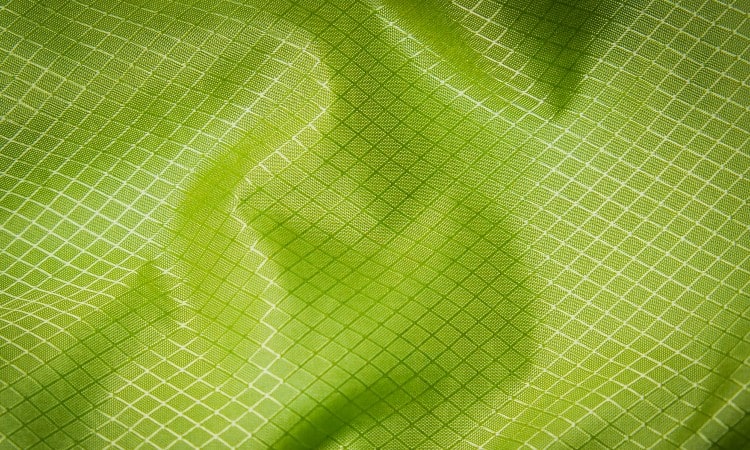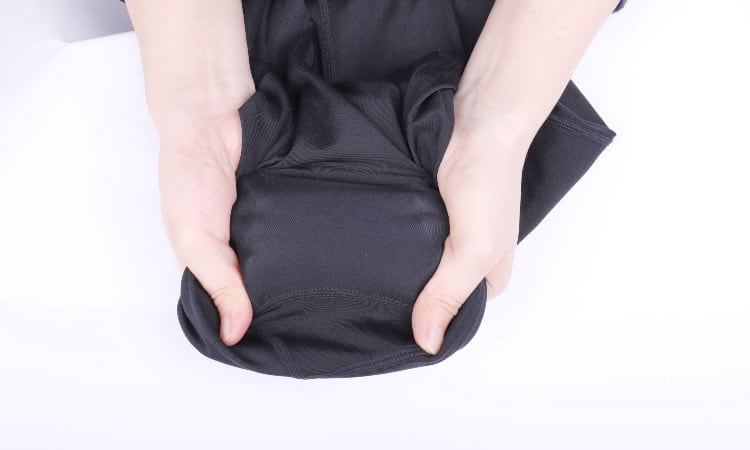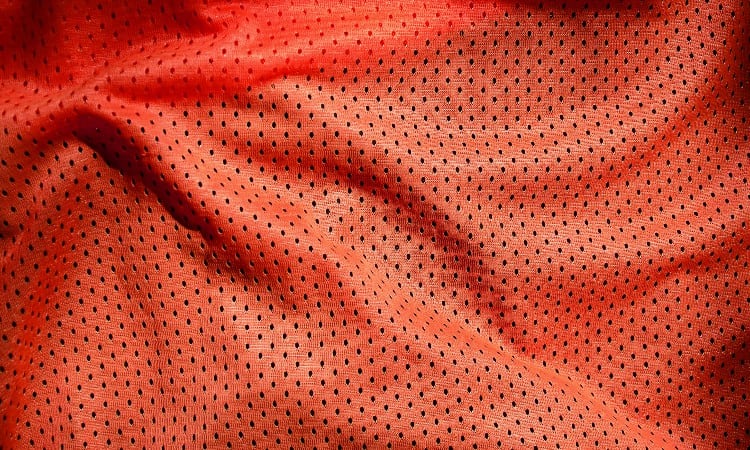Are you looking to use or make clothing that calls for stretchy fabric and are considering nylon. You may be wondering, is nylon stretchy?
When you think about how much of what we wear needs to have some stretch in them, you’ll no doubt come to appreciate stretchy fabrics more. Jeans, leggings, women’s stockings, linings, jackets — this doesn’t even cover non-clothing applications like bags, shoes, bandages, and wristbands.
Is nylon stretchy? Definitely. In fact, nylon is a popular choice not just for its elastic properties, but also because it is durable, easy to clean, cost-effective, resistant to shrinking, and retains its shape even after being stretched.
Want to learn more about this versatile and useful fabric? Sit back and relax because you’ve come to the right place. In this article, we learn more about nylon and delve deeper into the question: is nylon stretchy? We’ll also mention how stretchy it is, how to stretch it, nylon’s advantages and disadvantages, and other helpful information.

Is Nylon Stretchy Fabric?
As we’ve mentioned, yes, nylon is a stretchy fabric, but the amount of stretch you get depends on its make and blend. Pure nylon can be stretched 15 to 30% of its original size before the fibers start to break.
As a fabric, nylon gives any piece of clothing more stretch. Its wearer feels more comfortable as they go about their daily activities or workout.
What do I mean by stretch? In this context, nylon will stretch to fit the wearer’s unique body shape. It does not stretch forever and returns to its original shape when it isn’t being worn.
Its manufacturing process and ability to absorb water contribute to its elastic properties. Let’s take a quick look at how it’s made.
How Is Nylon Fabric Made?

Nylon fabric is made from diamine acid that is extracted from crude oil. The acid is then chemically combined with adipic acid to create a reaction that produces a polymer. The resulting polymer comes out in a crystallized form which is then heated and melted.
The next step in the process is called extrusion. It involves a metal spinneret that is used to make fibers out of the polymer solution. The resulting polymer fibers are loaded onto a bobbin and then wound onto another spool.
The final step entails weaving or knitting the fibers into the derided form after which it is ready for dyeing.
Does Nylon Stretch Over Time?
Pure nylon is a low-maintenance fabric that doesn’t stretch over time. It, therefore, doesn’t take a lot to keep it in good condition for many years.
Does nylon stretch with wear and washing? No, it doesn’t but it can if it’s mixed with the properties of other fabrics. It also won’t shrink after being soaked for a long time though it will absorb water quickly especially in humid conditions.
How well nylon keeps its shape also depends on what it’s blended with. A great example is your raincoat. Raincoats made of knitted nylon don’t stretch easily. They are tough and non-elastic, however, over time, knitted nylon will become slightly stretched.
If stretched beyond capacity, nylon will break down and can lose its shape faster than normal.
Some History
On its own, nylon isn’t such a great fabric. The first nylon material which came out in the 1920s to the 40s weren’t half as durable. However, it was soon discovered that this disadvantage could be easily overcome by combining it with other more durable materials like spandex, cotton, and polyester. By 2008, manufacturers were producing 12 million pounds of nylon a year, making up 12% of the global production of synthetic fibers.
Can You Stretch Nylon Fabric?

Some blends of fabric stretch better than others. Pure nylon fabric is made using nylon fibers only. In pure form, nylon does not stretch or shrink. If you try to shrink it, it may stretch instead. We’ll discuss later in greater detail specific nylon blends and how they affect nylon’s elasticity.
How to Stretch Nylon Clothing?
Is your nylon clothing too tight or uncomfortable to wear? You’ll be glad to know that there are ways you can stretch them. Here are two ways you can encourage nylon fabrics to fit better and get more stretch out of them:
Method One: Wear and Stretch Them While Wet
- Fill a bucket with hot water, roughly 50 or 60 degrees Celsius.
- Soak the clothing for 30 minutes.
- Put on the garment while wet.
- While you have it on, perform the workouts or movements that you’ll be using it for until it dries.
Once the clothing has dried, you’ll find it fits you more loosely. The fabric will continue to keep its new shape the more you wear it. Why does this work? The heat and moisture help the fibers relax as you soak and move around in them. An alternative to soaking is washing the nylon in your washing machine using the specified water temperature.
Method Two: Baby Shampoo and Weights
- Fill a bucket with warm water, about 20 to 30 degrees Celsius.
- Add 15 milliliters of baby shampoo and mix it well. (Baby shampoo can help the fibers stretch when mixed with warm water.)
- Put your nylon clothing in the bucket making sure to submerge them fully.
- Soak for 30 minutes and remove the clothing.
- Do not rinse the shampoo off but wring it to remove excess water. This way, the baby shampoo will continue to work by relaxing the fabric fibers.
- Lay your clothing on a flat surface and start pulling it in different directions. You can also stretch the fabric by using heavy materials like weights to keep it stretched. Alternatively, you can lay the weights on one side of the clothing while pulling on the other.
- Leave your weights on your clothing until it is completely dry.
Precautions to Take When Stretching Nylon Clothing
Stretching nylon may take some effort but it’s easy and convenient enough to do at home. Here are some things to keep in mind while stretching nylon on your own:
- When using the second method, don’t remove the weights until the fabric dries or it might go back to its original shape.
- Only stretch the fabric, not the seams. Some clothing is assembled using non-nylon thread which may break if seams are pulled too much.
- After stretching the fabric, use cold water to wash it.
- After washing, air-dry your clothing. Do not put it in the dryer, or it will shrink to its original size.
- Avoid stretching the fabric beyond its limit as it can cause the fibers to weaken and will shorten your clothing’s lifespan.
Remember that nylon is a strong and durable fabric, so you may not get the stretch you were hoping for by performing these methods once. You may have to give it a couple of tries before getting the results you want.
Can You Stretch Nylon Shoes?
The advantages and versatility of nylon weren’t lost on shoe manufacturers. By combining knit with nylon, Adidas was able to come up with a stretchy material with large gaps — what we commonly refer to as a mesh. This paved the way for many synthetic blends that we recognize today, including the Nike Flywire, a NASA-inspired fabric with a tensile strength five times greater than steel!
Despite what the internet will tell you, stretching any type of shoe is always a tricky process. There’s a big chance that it may not work, and you could damage the shoe itself. However, if you really want to give it a try, here’s what you can do:
- Fill up two bags with water. They should fit inside your shoes as snugly as possible when full.
- Seal them and insert them into your shoes.
- Store your shoes in the freezer until the water freezes.
Why am I telling you to do this? The logic behind this process is water expands when frozen. Remember how putting a bottle filled with water in the freezer could cause it to crack? That’s what should happen to your shoes sans the cracking.
Instead of tearing, the water will freeze, and the nylon will absorb the stretch then retain the new shape. However, as stated, this might not work on all nylon blends.
If you can afford it, just buy a new pair of shoes. You can always find someone in need who can use a pair of shoes. Getting them to stretch is harder and may not be worth the effort.
Does Nylon Stretch More Than Cotton?
Nylon is stretchier than cotton. Nylon doesn’t shrink when washed, but cotton does the first time it’s washed. Here are a couple more nylon versus cotton facts:
- Cotton is more absorbent. It can take in 25 times its own weight in water.
- Nylon can stretch more at 15 to 30% of its original size while cotton can only stretch by three to 5%.
- Nylon is made of synthetic fibers while cotton is natural.
- Nylon is more durable than cotton and is resistant to tears.
- Cotton is breathable and hypoallergenic whereas nylon isn’t.
Overall, cotton offers some stretchability, but its fibers will break down. Forcing it to stretch will make the fabric weaker and eventually wear it out. Nylon is still your best bet if stretch and strength are a big factor.
Does Nylon and Spandex Stretch Over Time?
Spandex is another synthetic fiber that nylon is often blended with. In terms of rigidity, nylon is better while spandex gives fabrics a smoother and softer quality.
When combined, a nylon-spandex fabric will give you a lot more stretch than nylon alone can. However, the fibers should be knitted together and not woven.
3 Ways to Stretch a Nylon-Spandex Blend
If you want to stretch a nylon-spandex blend, try the following:
- Soak the clothing in water and put it on wet. Move around and do your regular activities as you allow the fabric to dry.
- Put weight on one part of the clothing and stretch the other. Let the clothing dry as you repeat this on the other side.
- Prepare a bucket of warm water and add some baby shampoo or hair conditioner. Soak your nylon-spandex clothing in the solution.
Is Nylon More Stretchy Than Polyester?

Nylon’s biggest competitor in sportswear clothing is polyester. Both fabrics are made of synthetic fibers. They are durable, resistant to damage from chemicals and abrasion, and lightweight.
Here’s how they stack up against each other:
- Nylon is more stretchable.
- It is also absorbent while polyester is not.
- Water or moisture has a plasticizing effect on nylon, making it more flexible and moldable while reducing its strength and stiffness.
- More water will make nylon more stretchy while polyester will remain the same.
- Unlike nylon, polyester does not stretch. At best, it might stretch 12 to 15% from its original shape.
You might wonder why some of your polyester clothes are stretchable. The reason is it’s been blended with another fiber that can be stretched. Similar to nylon, polyester’s stretchiness will also depend on how the fabric was made.
Woven polyester is the least stretchy, but when blended with spandex or rayon it becomes stretchy. Knitted polyester is more stretchy than woven polyester but it can become more elastic by adding rayon or spandex.
What Are the Advantages and Disadvantages of Nylon?
Now that you’re better acquainted with nylon, its blends, and how it compares to other fabrics, let’s take a quick look at its overall pros and cons:
Advantages
- Nylon is stretchable and comes in varying degrees of elasticity.
- It is durable.
- It offers a lot of insulation.
- It is resistant to extreme temperatures.
- Nylon has great abrasion, corrosion, wear, and tear resistance.
- It has high tensile strength.
- It is lightweight.
- It can be lustrous, semi-lustrous, or dull.
Disadvantages
- Nylon isn’t biodegradable.
- It does not absorb a lot of water.
- Nylon does not hold color very well and can fade under the sun.
- Nylon won’t catch fire but it will melt.
Conclusion
Despite being a synthetic and non-biodegradable material, nylon continues to be a popular fabric for its elasticity, durability, and affordability. You most likely have some form of nylon in your wardrobe. As a modern society, we’ve come to expect a lot more from the fabrics that we choose to wear and nylon doesn’t disappoint.
What are your thoughts about nylon? How does your personal experience compare with the information presented? Did you enjoy reading this article? I’d love to hear from you in the comments below.